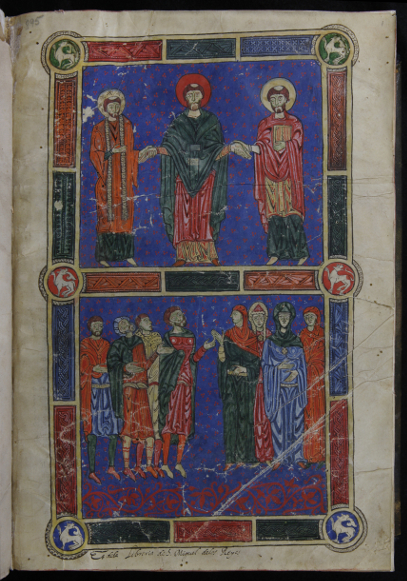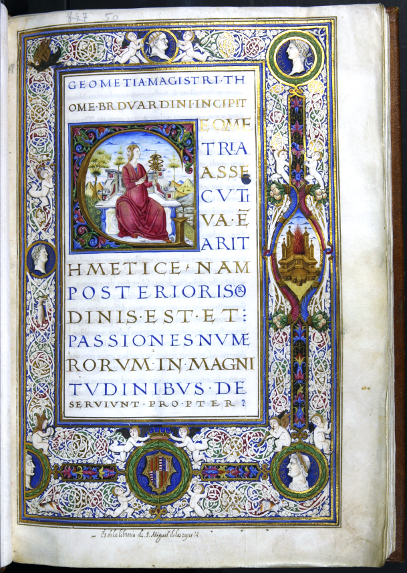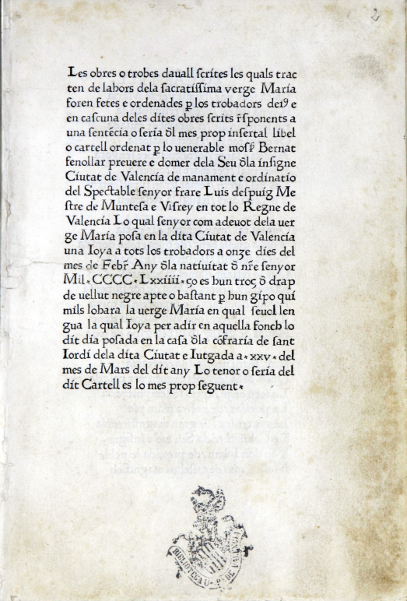![Francesc Eiximenis, Psalterium alias laudatorium, [València], [1442-1443]](/recursos/fatwirepub/ccurl/493/228/descobrint-tresors_850px.jpg)
Francesc Eiximenis, Psalterium alias laudatorium, [València], [1442-1443]
The written word transmitted throughout time is a treasure and indisputable witness of history. Libraries and archives are in charge of preserving and spreading these works, in some cases unique, rare or peculiar, which otherwise could have disappeared or being within reach of few people.
The exhibition is organised by the Libraries and Documentation Service and the Vice-Rectorate of Culture and Equality of the Universitat de València, which preserves, studies and aims to diffuse its rich inherited bibliographic funds. Its main objective is to show exceptional, unique, emblematic and significant works of the book history, which are object of personal enjoyment because of their artistic beauty as well as its historical and intellectual value.

In order to achieve this objective, 19 manuscripts and 7 incunabula have been selected. They form part of the bibliographic treasure kept by the Historical Library, which also preserves other treasures expanding until the 20th century, among which books, drawings and posters can be found. During the Spanish Civil War, they were kept at the Universitat de València, in a semi-basement of the library.
At the same time, the displayed bibliographic funds represent a testimony of the history of the university library, which dates from 1785 thanks to the donation of Francisco Pérez Bayer. After the vanishing of almost his whole collection because of a fire caused by a bomb during the Napoleonic invasion, the donations and legacies he received later as well as the incorporation of funds coming from the expropriation of ecclesiastical goods were decisive in order to configure the current library.

The confiscation of the 19th century was the beginning of the most valuable collection currently hold by the Universitat: the manuscripts of the Duke of Calabria, formed by a total of 246 codices coming from the monastery of San Miguel de los Reyes. Being prototypical examples of Renaissance codices of varied topics, they allow us to reconstruct the Neapolitan library of the kings of Aragon initiated by Alfonso V el Magnánimo (Alfonso the Magnanimous) and considered as one on the best royal libraries of the 15th century. This collection represents a symbol of European cultural union beyond political frontiers. Among its creators stand out the names of the best copiers, illustrators and bookbinders who worked in France, Naples, Lombardy, Spain, etc. It was initially created following an organising and selecting model of the courteous aristocratic written knowledge and it developed later following the humanistic and modern model of an authentic National Library. They are luxury books, in vellum, of a magnificent calligraphy, with a rich decoration plenty of gold and Renaissance motifs (exotic animals, medallions, banners, etc). They also preserve the original bookbinding.
Other works coming from monasteries are also kept at the Historical Library, as well as private donations mostly from people related to the Universitat, as it is the case of the rectors Vicente Blasco and Onofre Soler, the jurist Francisco Borrull, Ginés de Perellós, the Marquis of Dos Aguas, the professor and librarian Mariano Liñán and the librarians Domingo Mascarós Segarra and Vicente Hernández Máñez and others.
At the exhibition, among the manuscripts of the Duke of Calabria we can contemplate the most ancient model preserved by the library: Expositio psalmorun, by San Agustín, dated between 1150 and 1175. Besides, other examples of this beautiful collection, such as the codex of Francesco Filelfo, the gothic codex of Guillaume de Lorris Satyrae hecatosticae, a splendid volume with the works of Virgilio, Roman de la Rose; or the Psalterium of Francesc d’Eiximenis, made in Valencia.
At the incunabula exhibition – or first books printed before 1501, there are seven displayed works, among which two of them are remarkable due to their singularity and cultural value. On the one hand, Obres o trobes en llaors de la Verge Maria, printed in Valencia by Lambert Palmart in 1474. It is considered the first literary work printed in the Iberian Peninsula in a non-ambulant printer, whose one and only copy is kept by the Universitat de València. On the other hand, it stands out the magnificence of the work of Joanot Martorell, Tirant lo blanc, printed in Valencia by Nicolau Spindeler in 1490; a rare and emblematic model for all Valencians – there are only three copies in the world.
These treasures, among others, lie on the shelves of the university library. The aim of the Universitat de València is to preserve and disseminate its bibliographic heritage to reach the public interested in enjoying the texts and the beauty of the books. In order to do so it uses, among other means, bibliographic exhibitions as a form of approaching and, in many cases, of discovering the original works.
All the works displayed are full-text digitised and are available online from any corner of the world, through the digital collection called Somni, referring to the incunabula Lo somni de Joan Joan, by Jaume Gassull printed in Valencia in 1497.












